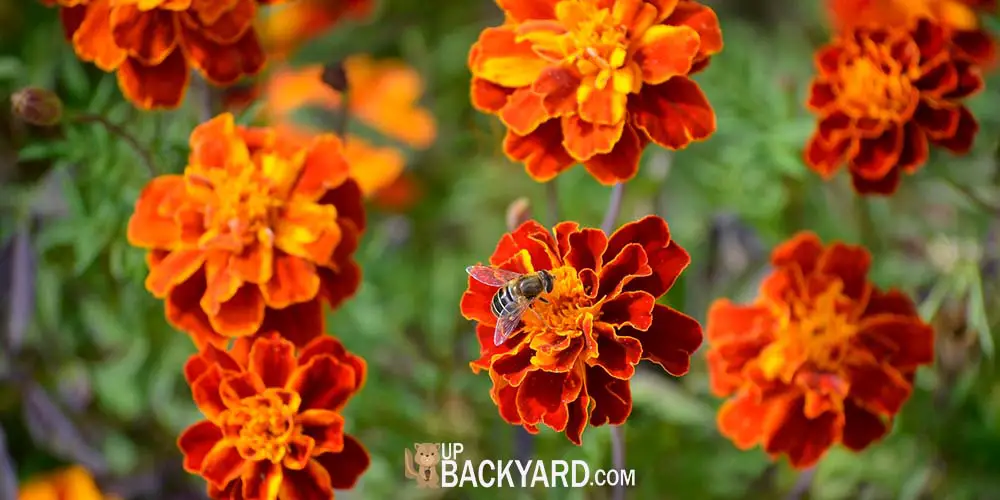Marigolds are known for their bright and vivid coloring and their strong smell.
While these flowers are notorious for repelling deer and rabbits from your garden space, do they attract any beneficial insects? Do marigolds attract bees?
Marigolds are very attractive to bees. Bees love the strong smell and vibrant colors of the marigold flowers.
These flowers also offer easy access to the pollen and nectar that the bee will drink and carry with them back to their hives.
Along with bees, butterflies are also attracted to marigold flowers making them a great addition to your pollinator garden this season.
Why Do Bees Like Marigolds
Bees are one of the most well-known and commonly thought of pollinators in today’s society.
Since pollination is so important, many people have begun creating pollinator-friendly flower gardens in their backyard spaces.
When you begin planning which flowers to grow in your garden, it helps to understand why bees like certain plants over other plants.
In the case of marigolds, bees like the shape, color, and smell of the plant.
Shape
The shape of the flower allows for easy access to the nectar inside. While the bee is drinking the nectar, which is a food source, it will collect pollen on its legs and body.
The pollen will then move from the male parts of the plants into the female part. This is the process of pollination. Once it is complete, the flower will be able to create seeds and reproduce.
Honey bees will also collect the pollen and take it back to their hives.
Once in their hives, the pollen will be turned into honey through a process in which the bee consumes the pollen and turns it into the golden substance we know and love as honey.
They also use pollen to create other substances like bee milk which is also called royal jelly.
Bees also love the open and flat shape of marigolds because it provides them with a place to rest while they gather the nectar and pollen.
Color
It is commonly thought that yellow is one of the bees’ favorite colors. However, it is much more complex than that.
Bees do not see color the way that humans see color. In fact, bees can see colors that humans cannot.
The spectrum of color a bee can see varies greatly more than that of a human. Bees can see ultraviolet rays and it is not entirely understood how this plays into nature.
When yellow is mixed with ultraviolet light, scientists call it bee’s purple. It is thought that bee’s purple is one of the bee population’s favorite colors.
While marigolds are golden with shades of oranges and yellow, there are some varieties that are red.
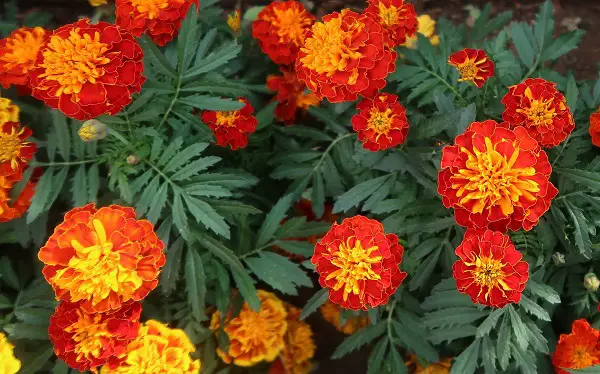
Bees do not have the photoreceptors to see the color red and will instead see black. If you are hoping to plant marigolds for bees this year, avoid choosing varieties with lots of red tones.
While yellow and orange are great for bees, they prefer blue, purple, and violet tones.
Since marigolds do not come in this color palette, try planting some other flowering shrubs or flowers that give off bold purple blooms like lilac or petunias.
Smell
It is no secret that marigolds have a strong and sometimes pungent smell. Unlike most plants that only give off scent through their flowers, marigolds have scent in their flowers, stems, and foliage, making it one aromatic plant.
While the smell is too much for deer and rabbits, bees love it. Plants that offer a strong scent can easily be picked up by bees even miles away.
What Other Plants Attract Bees?
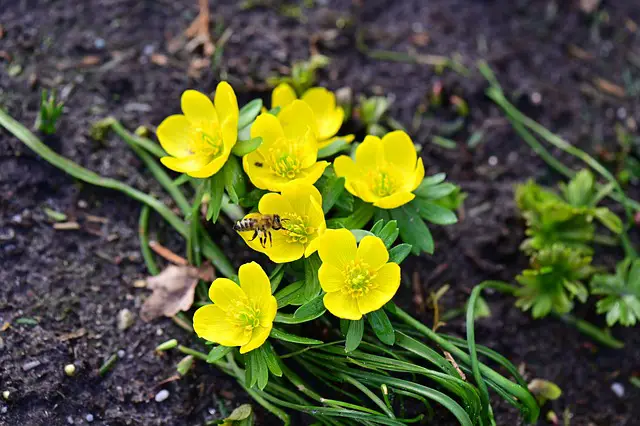
Now that you have your marigolds sorted for your pollinator garden, what else should you add?
It is best to choose a variety of flowers and flowering shrubs that will produce flowers at different points throughout the season.
You will want to create a consistent and steady food source for the pollinators.
Begin by planting tulips, hyacinths, or daffodils to provide much needed food for the bees and other pollinators after a long and cold winter.
After, choose plants that will provide long blooms throughout the summer and be sure to top off the fall season with late flowering plants to help them stock up before winter hits again.
You might also like: Does Lavender Attract Bees? (Here’s The Answer)
Annuals
It is best to grow a mix of annuals and perennials. Annuals bloom for one season and will die off in the cold.
However, annuals offer the benefit of blooms all summer long which will have bees and other pollinators flocking to your garden.
Try planting a mixture of alyssum, cleome, zinnias, sunflowers, salvia, calendula, and verbena and prepare for a busy summer of pollinator watching.
Many of these plants are also favorites of hummingbirds and butterflies!
Herbs
While many people plant herb gardens for culinary use, it is important to let some of your herbs go into bloom.
Most of the time, the gardener will cut the herb before it grows their flower for use in their home or professional kitchens.
Herbs will sprout colorful and delicate flowers if given a chance!
However, do not feel too guilty if you never give your herbs a chance to flower. Their strong scents can draw in bees and other pollinators where they will find an entire garden of other flowers waiting for them.
Try growing sage, thyme, borage, lavender, chives, dill, basil, oregano, rosemary, and mint in your herb and pollinator garden this season.
Early Season Flowers
When it comes time to choose which flowers to grow in your garden, be sure to include a few types from each season to help feed the bees all year long.
Vernal witch hazel, maples, willows, serviceberry, and redbud begin to flower early in the spring and can be some of the first buds you find each season.
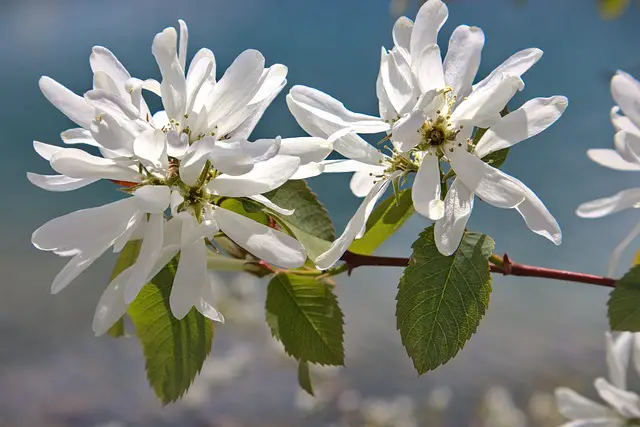
Fruit trees and shrubs like cherry, plum, raspberry, blackberry, and blueberry will also begin to flower early on in the spring season.
These will attract pollinators to their luscious flowers and once they are pollinated, will produce yummy fruit!
Other spring perennials to plant include golden alexanders, larkspur, dianthus, wild columbine, ajuga, lupine, baptisia, and pulmonaria.
Mid Summer Flowers
Once the early season flowers have all begun to fade, pollinators will be looking for the next round of flowers and flowering shrubs to take them into the next part of the season.
Around this time the weather would be warm enough to plant some flowering annuals as well.
In addition to the annuals, a few midsummer perennials to grow include anise hyssop, black-eyed Susans, coneflowers, catmint, cleome, penstemon, globe thistle, milkweed, bee balm, coreopsis, daisies, phlox, gaillardia, and yarrow.
Hyssop, milkweed, and globe thistle are also important for butterflies. Monarch butterfly caterpillars will only consume milkweed during that life stage.
Be sure to source native milkweed and you can watch the bold orange winged beauties fly around your garden this summer.
Late Summer Flowers
Slowly, the summer begins to fade into fall and most of the flowers will begin to die off. Bees will continue to work and feed until the cold of winter settles in.
To help provide them with enough food to store for the winter, be sure to grow some late bloomers.
Dahlias, asters, ironweed, goldenrod, Joe Pye weed, rudbeckias, and helianthus will continue to bloom until the cold of late autumn takes over. You can also grab some fall mums.
Where Do Bees Go In The Winter?
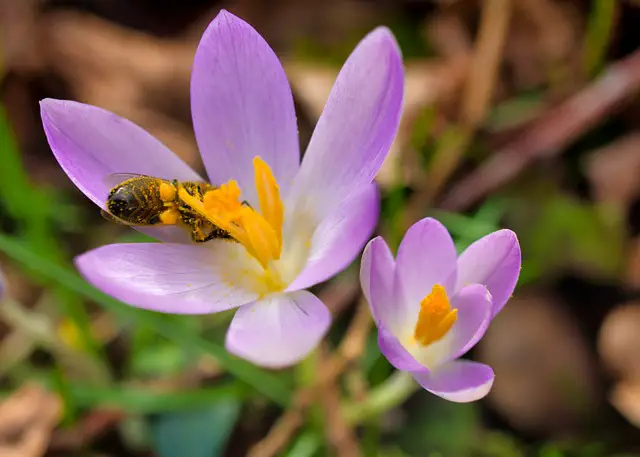
Bees spend the entire summer preparing for the winter months. Since the world outside gets too cold for them to go out and find food, they will remain in the hive for the entirety of the winter.
Once the temperature drops below 50°F, the bees will not leave their hives. Instead, they all gather as tight and as close as they can together to create warmth.
They will protect the queen and create a physical barrier between her and the cold. Once they have assumed the position, they will go dormant until the weather warms up again.
Worker honey bees tend to only live for 18-35 days in the summer. However, in the winter they will go dormant.
This will increase the lifespan of the dormant bees for up to 150 days to allow the hive to survive through the winter.
Key Takeaways
Bees and other pollinators are essential for our life on this planet.
Without them, there would be limited food to eat as almost all fruit and vegetable plants rely on these small creatures to help complete the process of pollination.
Due to their importance, many people have resorted to creating pollinator friendly gardens to increase the food sources for bees and butterflies.
Marigolds make a great addition to pollinator gardens. However, it is important to grow a variety of flowering plants that will create a constant and steady food source throughout the seasons.
Be sure to grow plants that will begin flowering in early spring when the pollinators awaken from their winter dormancy.
Growing annuals is a great way to create season-long colorful blooms that many pollinators like. Choose flowers that bloom in blue, violet or yellow to attract the most bees.
